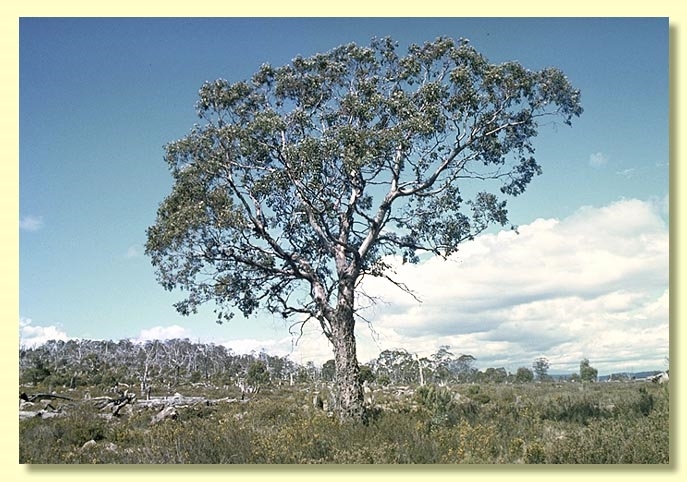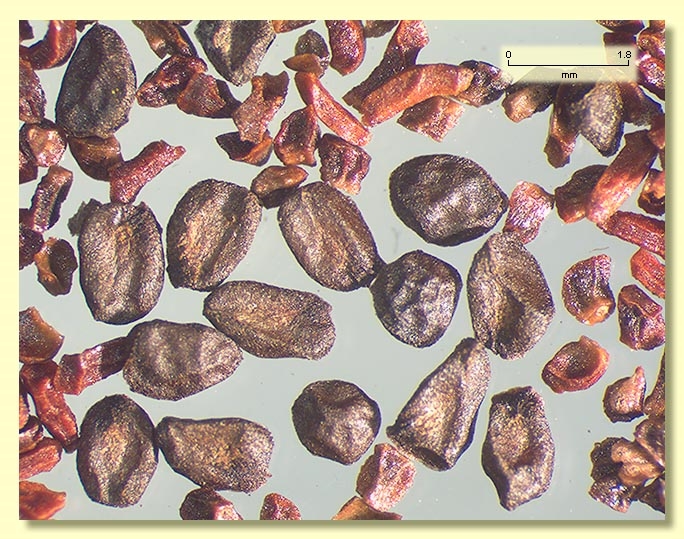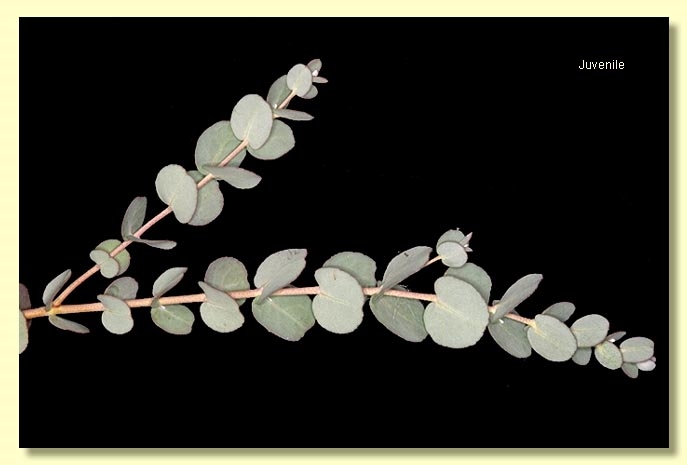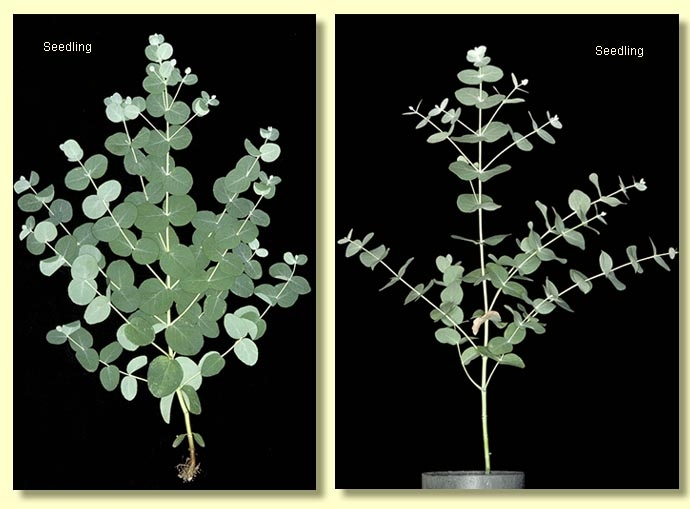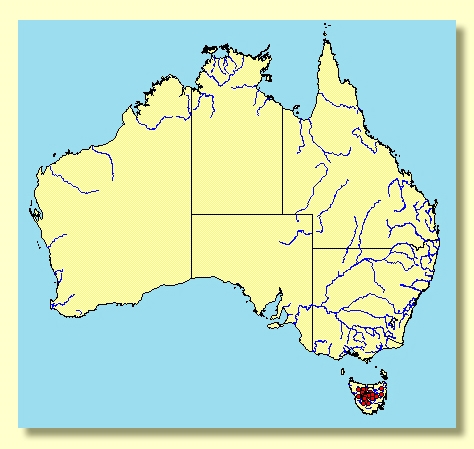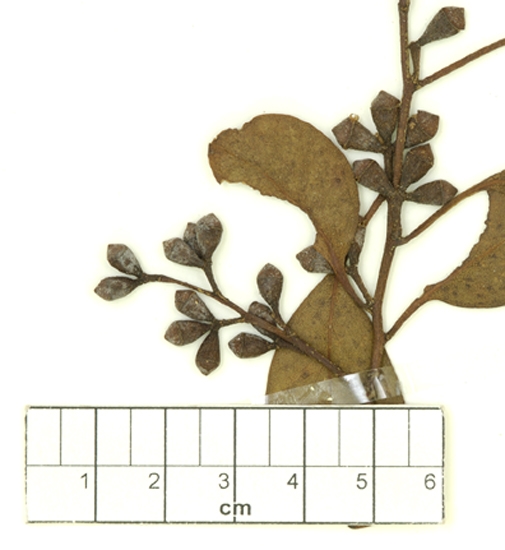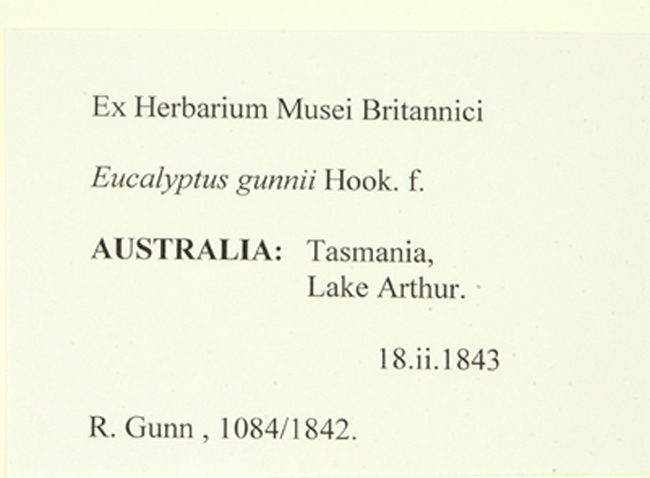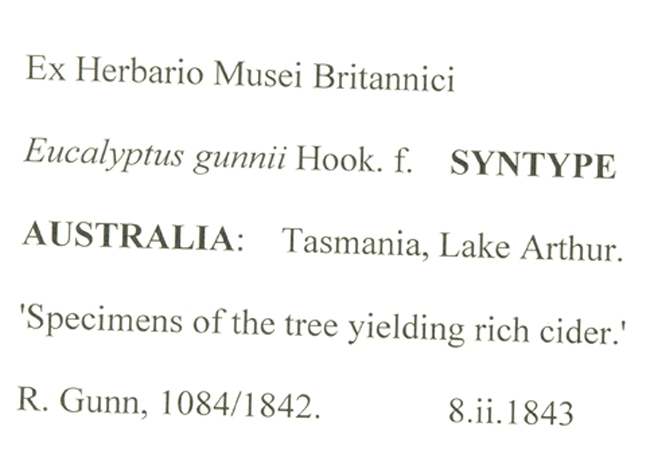Euclid - Online edition
Eucalyptus gunnii
Eucalyptus | Symphyomyrtus | Maidenaria | Euryotae | Orbiculares
Eucalyptus gunnii Hook.f., London J. Bot. 3: 499 (1844).
T: Tasmania: Lake Arthur, 18 February 1843, R. Gunn 1084/1842; lectotype: K [000279739]; isolectotype: NSW [NSW314848]; possible isolectotype: BM; fide Bean, A.R., Telopea 12(4): 517 (2010); possible isolectotypes: CANB [2 sheets CANB567586, 567837] fide A.V. Slee.
Eucalyptus gunnii var. montana Hook.f., Bot. Mag. 127: t. 7808 (1901) nom. illeg. p.p. not as to description. T: Lake Arthur, Tas., 18 Feb. 1843, R.C.Gunn 1080; syn: BM, HO, K; Lake Arthur, Tas., 18 Feb. 1843, R.C.Gunn 1082; syn: K; Lake Arthur, Tas., 18 Feb. 1843, R.C.Gunn 1084; syn: BM, CANB, CGE, HO, K, NSW.
Eucalyptus divaricata McAulay & Brett ex Brett, Proc. Roy. Soc. Tasmania for 1937: 94 (1938). T: not designated.
Eucalyptus gunnii subsp. divaricata (McAulay & Brett) B.M.Potts, Papers & Proc. Roy. Soc. Tasmania 135: 57 (2001). T: Tasmania: Miena, Great Lake, Sept. 1938, R.G.Brett s.n. (2.221, S3, H130); lecto: HO 16163; photo 1; isolecto: HO16165). See note below.
Bark smooth throughout or with some imperfectly decorticated rough bark on basal 1 m of trunk; smooth bark mottled white, yellow, pink, brown, green or grey, branchlets often conspicuously glaucous.
Juvenile stem rounded or square in cross section, glaucous or non-glaucous; juvenile leaves opposite and sessile for at least 40 nodes, broadly orbicular to cordate, 1.3–4.5 cm long, 1.7–4 cm wide, margin entire or crenulate, grey-green or glaucous. Crown often has conspicuously glaucous new growth.
Adult leaves alternate, petiole 0.9–2.3 cm long; blade lanceolate to elliptical to ovate, 4–9 cm long, 1.2–3.5 cm wide, or undulate, base tapering to petiole, concolorous, dull, grey-green to blue-green, side-veins greater than 45° to midrib, moderately to densely reticulate, intramarginal vein parallel to and just within margin or well removed from it, oil glands mostly intersectional or obscure.
Inflorescence axillary unbranched, peduncles 0.3–0.9 cm long, buds 3 per umbel, sessile or on pedicels to 0.4 cm long. Mature buds obovoid to ovoid, 0.5–0.9 cm long, 0.3–0.5 cm wide, glaucous to slightly glaucous weathering to green to reddish-brown, scar present, operculum slightly beaked to conical to rounded or flattened, stamens inflexed, anthers cuboid to oblong, versatile, dorsifixed, dehiscing by longitudinal slits (non-confluent), style long, stigma blunt, locules 3 or 4, the placentae each with 4 vertical ovule rows. Flowers white.
Fruit sessile or on pedicels to 0.3 cm long, cylindrical to barrel-shaped, often slightly contracted below rim, 0.5–0.9 cm long, 0.5–0.7 cm wide, sometimes slightly ribbed or angled longitudinally, glaucous or non-glaucous, disc descending, valves 3 or 4, near rim level or enclosed.
Seeds dark brown to black, 1–2.5 mm long, ovoid or flattened-ovoid, often pointed at one end, dorsal surface smooth, hilum ventral.
Cultivated seedlings (measured at ca node 10): cotyledons bilobed; stems rounded to square in cross-section, usually glaucous; leaves sessile and opposite for many nodes, orbicular to ovate, 1.5–5 cm long, 1.2–5 cm wide, base amplexicaul, margin entire or subcrenulate, apex emarginate to rounded, glaucous, paler on underside.
Flowering has been recorded in all months from September to April with peak flowering in December, January and February (see Williams & Potts, 1996, p. 73).
A small to medium-sized tree endemic to Tasmania, usually occupying poorly drained sites in cold upland areas.
Eucalyptus gunnii is closely related to E. archeri which has non-glaucous buds and fruit and greener adult leaves. From the other three-budded species, e.g. E. rubida, it differs by the cupular fruit. The often co-occurring E. coccifera has very glossy uncinate leaves, up to seven buds per inflorescence, warty buds with no operculum scar and larger obconical fruit.
Eucalyptus gunnii belongs in Eucalyptus subgenus Symphyomyrtus section Maidenaria, a large group of species more or less restricted to south-eastern Australia, characterised by bilobed cotyledons, simple axillary inflorescences, buds with two opercula, stamens with versatile anthers and flattened seeds with a ventral hilum. Within this section, E. gunnii, with nine other species, forms series Orbiculares having orbicular to cordate juvenile leaves opposite for many nodes, a grey-green to blue-green crown, and buds in threes. Series Orbiculares is confined to far south-eastern New South Wales, eastern Victoria and Tasmania.
Footnote: In a recent paper (Potts et al 2001) the identity of Eucalyptus gunnii subsp. divaricata as a recognizable taxon at this rank has been championed. It is distinguished from subsp. gunnii by the more glaucous branchlets, juvenile leaves, adult leaves, buds and fruit; the broader crown leaves; more cylindrical fruit; greater retention of juvenile leaves in the crown; differing chemical composition of leaf oils and leaf waxes; and a more rounded crown. At the same time it is acknowledged to grade clinally into other recognizable groups within the E. gunnii – E. archeri complex. In EUCLID we have not yet separated the two subspecies of E. gunnii. We have some difficulty separating specimens in the herbarium because of the existence of cline-forms in addition to the two described taxa. The reader is directed to the excellent paper referred to above for further information. Eucalyptus gunni subsp. divaricata is listed as "Endangered" under the Australian Government Environment Protection and Biodiversity Conservation Act 1999 (EPBC Act). More information may be found at this web address:
http://www.environment.gov.au/cgi-bin/sprat/public/sprat.pl

